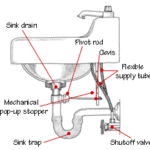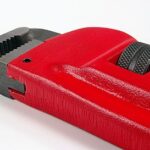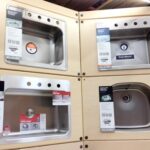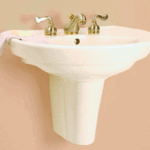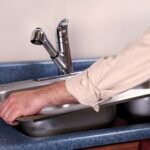How bathroom sink plumbing works, including a diagram of the drain plumbing assembly
A bath sink typically has two fixture holes on either 4-, 6-, or 8-inch centers. The wider types are meant to receive a split-set faucet, with faucet handles separate from the spout. The 4- or 6-inch holes may receive either a center set or a single-lever faucet. Flexible supply tubes carry water from shutoff valves at the wall to threaded tailpieces on the base of the faucet.
The drainpipe that runs through a bathroom sink usually is fitted with a pop-up stopper that raises and lowers when you pull up or push down on a knob or handle just behind the faucet body. The knob is actually the head of a lift rod fastened to a clevis, which is a connecting bar. The clevis connects to a pivot rod-and-ball assembly that consists of a rod that runs through a rubber pivot ball and slopes slightly uphill to the tailpiece of the stopper.
Pushing the knob and the lift rod down causes the pivot rod to push the stopper up; pulling the knob up causes the pivot rod to pull the stopper down. If you want to remove the assembly, you may be able to pull it right out. Or, you may have to twist it to unhook it from the clevis. (For more information, see How to Fix a Sink or Bathtub Pop-Up Drain Stopper.)
TOOLS AND MATERIALS NEEDED FOR INSTALLATION
| TOOLS | Adjustable wrench, pliers, screwdriver |
| MATERIALS | Faucet (split-set or center set/single-lever), flexible supply tubes, pop-up stopper assembly, plumber’s putty, sink drain assembly (drain body, locknut, tailpiece, drain trap and slip-joint couplings), escutcheon trim |
The sink drain has a flange that is sealed to the sink hole with plumber’s putty. This flange is screwed into the drain body, which is tightened to the underside of the sink bowl with a locknut.
The tailpiece, which may be fitted to a pop-up stopper, attaches to a drain trap by means of slip-joint couplings. A sink trap remains filled with water so that sewer gases can’t enter the room; the trap is connected to a threaded nipple inserted in a T in the drain line. An escutcheon trim hides the connection.
A mechanical pop-up stopper is operated by a system of levers and rods. If this isn’t working properly, the solution is usually just a matter of adjusting the clevis screw or the position of the pivot rod.
Bathroom Sink Plumbing FAQs
- What types of faucets can be used with a bathroom sink?
Bathroom sinks typically accommodate split-set faucets and center set or single-lever faucets. Split-set faucets have separate handles for hot and cold water and require wider fixture holes, either 6 or 8 inches apart. Center set or single-lever faucets can fit into either 4-inch or 6-inch holes and integrate the faucet and handles into a single unit.
- How does the water get to the faucet in a bathroom sink?
Water is supplied to the faucet through flexible supply tubes. These tubes connect the water shutoff valves located beneath the sink to the threaded tailpieces on the faucet’s base.
- What is the purpose of the pop-up stopper in a bathroom sink?
To remove a pop-up drain stopper assembly, you can either pull it straight out or twist it to detach it from the pivot rod mechanism, depending on the assembly design.
- How is the sink drain assembled?
The sink drain includes a flange that is sealed to the sink hole using plumber’s putty. This flange is attached to the drain body, which is secured to the underside of the sink with a locknut. The tailpiece of the drain attaches to the drain trap via slip-joint couplings.
- What function does the sink trap serve?
The sink trap is a crucial U-shaped drain pipe that holds a small amount of water to prevent sewer gasses from traveling through the drain pipe and entering the bathroom.
- What hides the plumbing connections at the wall?
An escutcheon trim is used to cover and beautify the connection between the plumbing pipes and the wall, providing a neat appearance.
- How can you fix a non-functioning mechanical pop-up stopper?
If a mechanical pop-up stopper isn’t working properly, it often can be fixed by adjusting the clevis screw or repositioning the pivot rod to ensure proper operation of the mechanism. As a last resort, you can remove it and replace it with a simple replacement pop-up that you simply push down to seal the drain.



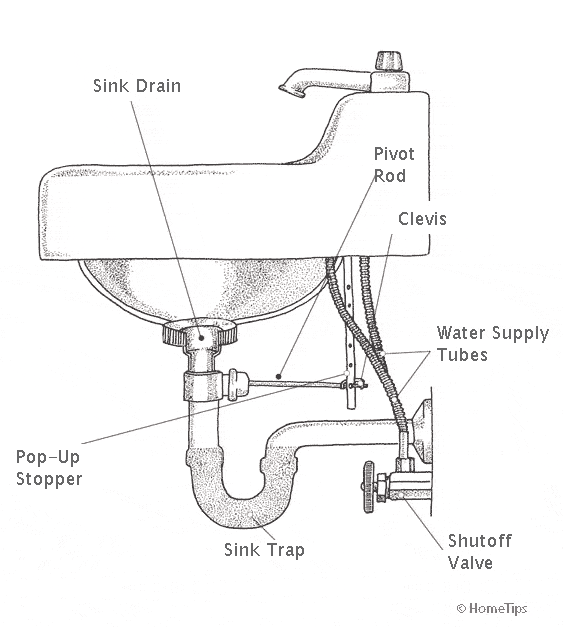
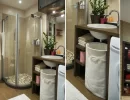



 Don Vandervort writes or edits every article at HomeTips. Don has:
Don Vandervort writes or edits every article at HomeTips. Don has:
